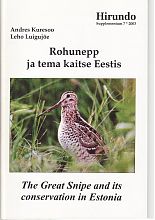Supplementum 7/2003
Andres Kuresoo
Leho Luigujõe
The Great Snipe and its conservation in Estonia
Abstract
This publication is based on the Estonian national management plan for the Great Snipe Gallinago media between 2002 and 2006. The Great Snipe is defined in the IUCN Red Data Book as a near-threatened species of birds, which is why the international action plan for the species was compiled. This species is thoroughly studied only in few European countries; therefore, the results of studies carried out in Estonia were of great importance in compiling the issue. The western population of the Great Snipe has perished and nowadays the species breeds only in Eastern Europe and Scandinavia. In Estonia, approximately 70 persistent breeding sites are recorded, although the number of leks may exceed a hundred. The Estonian population is estimated to comprise 600 to 800 males.
The breeding sites of the Great Snipe are mainly located in larger floodplain meadows. The species favors open or semi-bushy meadows; it survives better on mown or grazed sites. As the management of meadows has barely been profitable in the last dozen years, by now the Estonian population of the Great Snipe is concentrating to protected areas, where the management of meadows is supported by the government. Nowadays, the more numerous and vital populations are located on the wetlands of the Suur-Emajõgi, Kasari and Mustajõgi Rivers in addition to the wetlands of Soomaa. Leks are also known to be located on mires, previously dammed but currently abandoned polder areas and even on clear-cut forest areas. The Great Snipe forages for mainly soil-invertebrates, mostly earthworms. Although data on the reproduction of the Great Snipe are insufficient, the status of its population in Estonia may still be considered to be fair. The main factors of threat are the destruction of lekking and nesting sites, untimely mowing, instability of natural conditions (spring floods, fires) and probably the increasing numbers of predators.
The Great Snipe is under strict protection on the basis of the EU Bird Directive and several conventions. According to the Estonian Red Data Book, the Great Snipe is endangered and legally a category 2-protected species. To protect the Estonian population of the species, its habitat should be maintained, surveys on the condition of the population as well as species introduction improved. Management plan defines for these purposes 16 essential activities. For habitat conservation, larger floodplain meadows should be protected from overgrowth; their destruction by drainage or other means should be avoided. Researchers should arrange surveys on Great Snipe numbers, specify the requirements on its habitat and identify success in applied means of conservation. Raising awareness of Great Snipe introduction has already begun – a profound leaflet on the biology and protection of the species has been issued and one of the best known leks of the Great Snipe at Kärevere is provided with informative boards. In 2006, experts should evaluate the efficiency of outlined means and plan further implications of species conservation.

